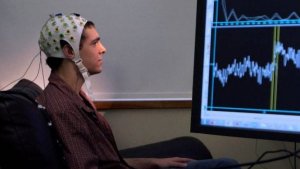Neurogaming: Playing with Your Brain

Neurogaming is a new way to play video games. It involves using your brain waves to perform actions within the games. This new technique emerged from the latest advances in gaming as well as neuroscience.
Some experts are convinced that the next revolution in gaming is going to involve neurology. Nevertheless, neuroscience can also benefit from digital recreation. That’s because games can help this field diagnose and treat certain psychological conditions.

Nowadays, many video games make use of neurogaming for mental health. This leap in technology has created a good deal of expectation. That goes for both the entertainment field as well as for neuroscience.
How does neurogaming work?
Neurogaming is mainly based on DNI (direct neural interface) technology. The process starts with a device that’s charging brain waves through a set of very sensitive voltmeters. Someone places them on the person’s skull. Then, a computer processes and interprets them. In other words, it allows a person to interact with a computer program with their thoughts.
When you think about or imagine something, the brain emits certain brain waves. Machines can measure and transmit them to a computer program. For example, a computer might even be able to differentiate between different concentration levels. It processes this data to then reproduce it as a movement or action in a video game.
The technology that makes neurogaming possible takes into account the fact that every brain is different. The first thing that this technology does is discover how each person’s brain works. That way, the computer can interpret the brain waves more precisely. This allows it to adapt to each particular case.
The direct neural interface applied to neurogaming allows a person to play a video game without using physical controls. A helmet and a person’s eyes on the image in front of them is enough. With it, they’re able to execute certain commands within the game.
Current limitations of neurogaming
Although the technology that makes neurogaming possible is currently available and easy to access, researchers are still studying it. That’s because this technology has very general applications. The people who initially developed it didn’t expect others to apply it to video games. For many researchers, though, it won’t take them long to develop a new more specialized type of technology for gaming.
On the other hand, existing technology can only read a very small number of mental patterns. Aside from that, the computers and other machines that read and interpret the brain waves take a long time to do it. That’s why, if developers want to provide a truly complex and entertaining experience, the technology has to improve. Its speed and the number of commands it can read need to increase dramatically.
Those who are developing these technologies believe that, in the near future, neurogaming will improve. It’ll use a wide variety of brain waves. However, it’ll also be able to use physiological factors. Some examples of these factors are heart rate, facial expressions, and pupil movements, among others.

Application for the treatment and diagnosis of psychological problems
Matias Palva is a researcher from the Neuroscience Center at the Helsinki Institute of Life Science (HiLIFE) of the University of Helsinki. According to him, neurogaming can make three important contributions to neuroscience and psychology:
- Training the brain to be healthy for much longer. This is because the brain is entertained for much longer.
- Diagnosing some mental disorders. Depending on the players’ performance, professionals might obtain signs pointing to possible mental or cognitive decline.
- Treating the mental disorders that professionals find through the games. In the future, experts may be able to apply neurogaming to the treatment of different neurological problems. Some examples are Alzheimer’s disease or schizophrenia. They might also use it to control negative emotions or insomnia.
As of today, one video game uses neurogaming. It’s called “Throw Trucks with Your Mind”. Some experts are using it to treat attention-deficit/hyperactivity disorder (ADHD). They ask players to slow or speed up their brain waves in order to control a truck in the air. Another video game of this type that’s also available is NeuroRacer. Its goal is to measure and repair the neural deterioration the aging process produces.
All cited sources were thoroughly reviewed by our team to ensure their quality, reliability, currency, and validity. The bibliography of this article was considered reliable and of academic or scientific accuracy.
- Crespo Pereira, V. (2015). Neurogaming: El papel de la neurociencia en la industria del videojuego. Ponencia presentada en la Conferencia Internacional sobre Cine, Arte, Tecnología e Comunicación en Avanca, Portugal.
This text is provided for informational purposes only and does not replace consultation with a professional. If in doubt, consult your specialist.








